Introduction
The results reported in the January 2022 bank lending survey (BLS) relate to changes observed during the fourth quarter of 2021 and expectations for the first quarter of 2022. The survey was conducted between 13 December 2021 and 11 January 2022. A total of 152 banks were surveyed in this round, with a response rate of 100%. In addition to results for the euro area as a whole, this report also contains results for the four largest euro area countries.[1]
A number of ad hoc questions were included in the January 2022 survey. They address the impact of the situation in financial markets on banks’ access to retail and wholesale funding, the impact of new regulatory and supervisory requirements on banks’ lending policies, the impact of banks’ non-performing loan (NPL) ratios on their lending policies, the change in bank lending conditions and loan demand across the main economic sectors, and the impact of government loan guarantees related to the coronavirus (COVID-19) pandemic on changes in banks’ lending conditions and demand for loans.
1 Overview of results
In the January 2022 BLS, euro area banks indicated a very slight net tightening of credit standards on loans to enterprises in the fourth quarter of 2021, i.e. the percentage share of banks reporting a tightening of credit standards was slightly larger than the share of banks reporting an easing. Banks had a generally benign view of firms’ credit risks, mainly related to their overall positive assessment of the economic outlook, despite the current pandemic situation and the dampening impact of supply bottlenecks. Banks reported a net easing impact of risk perceptions and a broadly unchanged impact of their risk tolerance. In the first quarter of 2022, banks expect credit standards to remain broadly unchanged for loans to firms.
Banks indicated, on balance, a considerable increase in firms’ demand for loans in the fourth quarter of 2021, which is the largest net increase since the extraordinary rise in loan demand in the first half of 2020. This appears consistent with the recent increase in actual loan growth to euro area firms. Loan demand was driven by short-term working capital needs, likely related to supply bottlenecks, but also by a significant pick up in firms’ longer-term financing needs for fixed investment, which provides an overall positive sign for the economic recovery, despite the dampening impact of the pandemic on the economy. In the first quarter of 2022, banks expect a continued increase in demand for loans to firms.
Credit standards remained unchanged for housing loans, while banks reported a moderate net easing for credit standards on consumer credit in the fourth quarter of 2021. For housing loans, risk tolerance and cost of funds had a slight net tightening impact, whereas for consumer credit, these factors had a small net easing impact. Risk perceptions and competition had a broadly neutral impact for loans to households. Banks reported, on balance, a continued increase in demand for loans to households for house purchase and, to a smaller extent, for consumer credit in the fourth quarter of 2021, supported by consumer confidence and the low general level of interest rates. In the first quarter of 2022, banks expect a net tightening of credit standards for housing loans and a net easing for credit standards on consumer credit. On balance, banks expect a continued net increase in demand for loans to households across loan categories.
In more detail, euro area banks reported a very slight net tightening of credit standards (i.e. banks’ internal guidelines or loan approval criteria) for loans or credit lines to enterprises in the fourth quarter of 2021 (net percentage of banks of 2%, after 1% in Q3 2021; see Section 2.1). Following the stronger tightening in earlier periods of the pandemic, banks have indicated in the fourth quarter of 2021 an overall benign view of firms’ credit risks. This was mainly related to an easing impact from banks’ assessment of the economic outlook and a broadly unchanged impact of their risk tolerance, despite supply bottlenecks and the Omicron variant which are likely to dampen the short-term economic outlook. The impact of banks’ cost of funds and balance sheet situation on their credit standards remained broadly neutral, reflecting the continued support from monetary policy, which has so far shielded banks and borrowers from the rise in market reference rates. In the first quarter of 2022, euro area banks expect broadly unchanged credit standards on loans to firms (-1%).
In the fourth quarter of 2021, euro area banks reported unchanged credit standards for housing loans (net percentage of banks of 0%, after 2% in Q3 2021; see Section 2.2), while credit standards have eased in net terms for consumer credit and other lending to households (-4%, after -3%; see Section 2.3). For housing loans, banks’ decreased risk tolerance as well as their cost of funds and balance sheet situation had a small tightening impact, while these factors had a small easing impact for consumer credit. In addition, risk perceptions and competition had a broadly neutral impact on credit standards for all lending to households. Banks expect credit standards to tighten for housing loans (3%) and to continue easing for consumer credit (-6%) in the first quarter of 2022.
Banks’ overall terms and conditions (i.e. banks’ actual terms and conditions agreed in the loan contract) for new loans to enterprises remained unchanged in the fourth quarter of 2021 (net percentage of 0%, after -2%). Margins on average loans (defined as the spread over relevant market reference rates) continued to narrow in net terms, while margins on riskier loans widened moderately. Banks reported broadly unchanged overall terms and conditions for housing loans (net percentage of -1%, after 0%) and consumer credit and other lending to households (-1%, after 0%) in the fourth quarter of 2021. The developments in margins are consistent with lending rates, which have remained close to historical lows in recent months.
In the fourth quarter of 2021, banks reported on balance no change in the share of rejected applications for loans to firms (net percentage of 0%, after 1%). For housing loans, euro area banks reported a slight net increase in the share of rejected applications (2%, after 3%), while the share of rejected applications has decreased in net terms for consumer credit (-3%, after -2%).
Among the largest euro area countries, credit standards for loans to enterprises remained unchanged in Germany and France, while they tightened in Spain and eased in Italy in the fourth quarter of 2021 (see Overview table). Credit standards for housing loans tightened in Germany and Spain, eased in Italy and remained unchanged in France. Credit standards for consumer credit and other lending to households eased in France and Italy, remained unchanged in Germany and tightened in Spain.
Firms’ demand for loans increased considerably, on balance, in the fourth quarter of 2021 according to the banks (net percentage of 18%, after 8% in Q3 2021; see Section 2.1). This was the highest net increase since the extraordinary rise in loan demand in the first half of 2020. Loan demand was mainly driven by a stronger positive contribution of firms’ financing needs for both working capital and fixed investment compared with the previous quarter, consistent with the net increase in demand for short-term and long-term loans reported by banks and the pick-up in actual lending to euro area firms across maturities. While the net increase in financing needs for working capital is likely related to the current pandemic situation, production delays and the rebuilding of inventories resulting from supply bottlenecks, firms’ loan demand for fixed investment provides an overall positive sign for the economic recovery, despite the dampening impact of the pandemic. In addition, banks continued to report a positive impact on loan demand from other financing needs, which include M&A activity and debt refinancing and restructuring, while the impact of alternative financing sources was broadly neutral. In the first quarter of 2022, banks expect a continued net increase in demand for loans to firms (net percentage of 8%).
Similar to the previous BLS round, banks reported a net increase in demand for housing loans (net percentage of 8%, after 11% in Q3 2021; see Section 2.2) and, to a smaller extent, for consumer credit in the fourth quarter of 2021 (net percentage of 2%, after 5%; see Section 2.3). This is in line with the dynamic lending for house purchase and the moderate consumer credit growth observed recently, albeit remaining weak overall. Consumer confidence and the low general level of interest rates continued to support the demand for loans to households across loan categories. In addition, housing market prospects had a positive impact on the demand for housing loans, whereas spending on durables had a small negative impact on consumer credit. The dampening impact of the use of alternative sources of finance was related to loans from other banks, which had a negative impact on the demand for housing loans and consumer credit according to the banks surveyed. For consumer credit, the dampening impact was also related to the use of internal finance out of savings. Banks expect a continued increase in the net demand for housing loans (6%) and for consumer credit (12%) in the first quarter of 2022.
Among the largest euro area countries, banks reported a net increase in demand for loans to enterprises in Germany, France and Italy, while loan demand remained unchanged according to banks in Spain in the fourth quarter of 2021. Net demand for loans to households increased in Germany, Spain and Italy. In France, net demand for housing loans remained unchanged, whereas it decreased for consumer credit.
Overview table
Latest BLS results for the largest euro area countries
(net percentages of banks reporting a tightening of credit standards or an increase in loan demand)
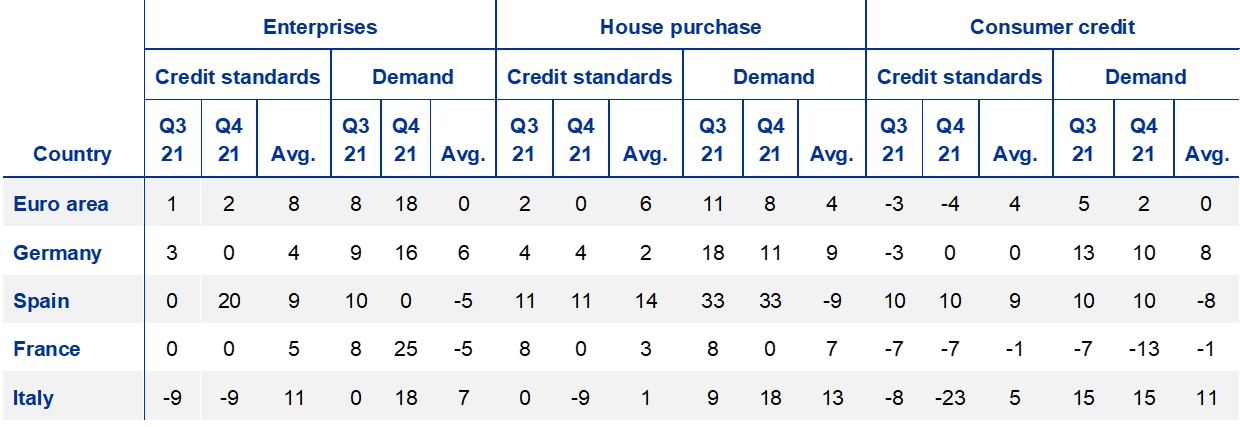
Notes: The “Avg.” columns contain historical averages, which are calculated over the period since the beginning of the survey, excluding the most recent round. Owing to the different sample sizes across countries, which broadly reflect the differences in the national shares in lending to the euro area non-financial private sector, the size and volatility of the net percentages cannot be directly compared across countries.
The January 2022 BLS also included a number of ad hoc questions. Regarding euro area banks’ access to retail and wholesale funding, banks reported in net terms that access continued to improve for retail funding in the fourth quarter of 2021. By contrast, it was broadly unchanged for money markets, debt securities and securitisation.
Euro area banks continued to improve their capital position against the backdrop of regulatory or supervisory action in 2021. At the euro area level, banks reported that supervisory or regulatory action had a net tightening impact on banks’ credit standards on loans to large firms, on consumer credit and in particular on loans for house purchase in 2021. The relatively stronger tightening impact on loans to households for house purchase was probably related to macroprudential measures on housing markets in some countries.
In the second half of 2021, euro area banks’ non-performing loan (NPL) ratios had a small net tightening impact on credit standards for loans to enterprises and for consumer credit, whereas the impact continued to be neutral on credit standards for loans to households for house purchase. Over the next six months, euro area banks expect NPL ratios to have a broadly neutral impact on credit standards across all loan categories. Pressure related to supervisory or regulatory requirements as well as banks’ decreased risk tolerance contributed to a small net tightening impact of NPL ratios on lending conditions in the second half of 2021. At the same time, costs related to banks’ capital position and balance sheet clean-up operations, banks’ access to market financing and liquidity position continued to have a broadly neutral impact on lending conditions via banks’ NPLs.
Euro area banks indicated moderately tightened or broadly unchanged credit standards for new loans to enterprises across the main economic sectors in the second half of 2021, in line with broadly unchanged credit standards reported by banks for loans to all firms in the third quarter of 2021 and the slight net tightening of credit standards in the fourth quarter. Over the next six months, banks expect broadly unchanged credit standards or a net tightening in credit standards across most of the economic sectors. Banks reported on balance an increase in demand for loans or credit lines in all economic sectors, with the net increase being most pronounced in real estate and manufacturing. Over the next six months, euro area banks expect a continued net increase in loan demand from firms across all main economic sectors.
Euro area banks reported that COVID-19 related government guarantees continued to support banks’ credit standards for loans to firms in the second half of 2021. Demand for loans with COVID-19 related government guarantees declined on balance, whereas it strongly increased in net terms for loans without government guarantees in the second half of 2021. Given the small share of loans with COVID-19 related guarantees in new lending, this is in line with the overall increase in loan demand from firms in the third and fourth quarters of 2021 (see Section 2.1).
Box 1
General notes
The bank lending survey (BLS) is addressed to senior loan officers at a representative sample of euro area banks. In the current round, 152 banks were surveyed, representing all euro area countries and reflecting the characteristics of their respective national banking structures. The main purpose of the BLS is to enhance the Eurosystem’s knowledge of bank lending conditions in the euro area.[2]
BLS questionnaire
The BLS questionnaire contains 22 standard questions on past and expected future developments: 18 backward-looking questions and four forward-looking questions. In addition, it contains one open-ended question. Those questions focus on developments in loans to euro area residents (i.e. domestic and euro area cross-border loans) and distinguish between three loan categories: loans or credit lines to enterprises; loans to households for house purchase; and consumer credit and other lending to households. For all three categories, questions are asked about the credit standards applied to the approval of loans, the terms and conditions of new loans, loan demand, the factors affecting loan supply and demand conditions, and the percentage of loan applications that are rejected. Survey questions are generally phrased in terms of changes over the past three months or expected changes over the next three months. Survey participants are asked to indicate in a qualitative way the strength of any tightening or easing or the strength of any decrease or increase, reporting changes using the following five-point scale: (1) tightened/decreased considerably, (2) tightened/decreased somewhat, (3) basically no change, (4) eased/increased somewhat or (5) eased/increased considerably.
In addition to the standard questions, the BLS questionnaire may contain ad hoc questions on specific topics of interest. Whereas the standard questions cover a three-month time period, the ad hoc questions tend to refer to changes over a longer time period (e.g. over the past and next six months).
Aggregation of banks’ replies to national and euro area BLS results
The responses of the individual banks participating in the BLS are aggregated in two steps to form the euro area results. In the first step, the responses of individual banks are aggregated to national results for the euro area countries. In the second step, the national BLS results are aggregated to euro area BLS results.
In the first step, banks’ replies are aggregated to national BLS results for all countries by applying equal weights to all banks in the sample.[3] For two countries (Malta and Slovakia), national results are additionally aggregated by applying a weighting scheme based on the amounts outstanding of loans to non-financial corporations and households of the individual banks in the respective national samples.
In the second step, since the numbers of banks in the national samples differ considerably and do not always reflect those countries’ respective shares of lending to euro area non-financial corporations and households, the unweighted national survey results of all countries are aggregated to euro area BLS results by applying a weighting scheme based on the national shares of outstanding loans to euro area non-financial corporations and households.
BLS indicators
Responses to questions relating to credit standards are analysed in this report by looking at the difference (the “net percentage”) between the percentage of banks reporting that credit standards applied in the approval of loans have been tightened and the percentage of banks reporting that they have been eased. For all questions, the net percentage is determined on the basis of all participating banks that have business in or exposure to the respective loan categories (i.e. they are all included in the denominator when calculating the net percentage). This means that banks that specialise in certain loan categories (e.g. banks that only grant loans to enterprises) are only included in the aggregation for those categories. All other participating banks are included in the aggregation of all questions, even if a bank replies that a question is “not applicable” (“NA”). This harmonised aggregation method was introduced by the Eurosystem in the April 2018 BLS. It has been applied to all euro area and national BLS results in the current BLS questionnaire, including backdata.[4] The resulting revisions for the standard BLS questions have generally been small, but revisions for some ad hoc questions have been larger owing to a higher number of “not applicable” replies by banks.
A positive net percentage indicates that a larger proportion of banks have tightened credit standards (“net tightening”), whereas a negative net percentage indicates that a larger proportion of banks have eased credit standards (“net easing”).
Likewise, the term “net demand” refers to the difference between the percentage of banks reporting an increase in loan demand (i.e. an increase in bank loan financing needs) and the percentage of banks reporting a decline. Net demand will therefore be positive if a larger proportion of banks have reported an increase in loan demand, whereas negative net demand indicates that a larger proportion of banks have reported a decline in loan demand.
In the assessment of survey balances for the euro area, net percentages between -1 and +1 are generally referred to as “broadly unchanged”. For country results, net percentage changes are reported in a factual manner, as differing sample sizes across countries mean that the answers of individual banks have differing impacts on the magnitude of net percentage changes.
In addition to the “net percentage” indicator, the ECB also publishes an alternative measure of banks’ responses to questions relating to changes in credit standards and net demand. This measure is the weighted difference (“diffusion index”) between the percentage of banks reporting that credit standards have been tightened and the percentage of banks reporting that they have been eased. Likewise, as regards demand for loans, the diffusion index refers to the weighted difference between the percentage of banks reporting an increase in loan demand and the percentage of banks reporting a decline. The diffusion index is constructed in the following way: lenders who have answered “considerably” are given a weight (score of 1) which is twice as large as that given to lenders who have answered “somewhat” (score of 0.5). The interpretation of the diffusion indices follows the same logic as the interpretation of net percentages.
Detailed tables and charts based on the responses provided can be found in Annex 1 for the standard questions and Annex 2 for the ad hoc questions. In addition, BLS time series data are available on the ECB’s website via the Statistical Data Warehouse.
A copy of the questionnaire, a glossary of BLS terms and a BLS user guide with information on the BLS series keys can all be found on the ECB's website.
2 Developments in credit standards, terms and conditions, and net demand for loans in the euro area
2.1 Loans to enterprises
2.1.1 Credit standards for loans to enterprises tightened very slightly
Euro area banks reported a very slight net tightening of credit standards (i.e. banks’ internal guidelines or loan approval criteria) for loans or credit lines to enterprises in the fourth quarter of 2021, i.e. the percentage share of banks reporting a tightening of credit standards was slightly larger than the share of banks reporting an easing (net percentage of banks of 2%, after 1% in the third quarter of 2021; see Chart 1 and Overview table). This is overall consistent with banks’ expectations of broadly unchanged credit standards in the previous quarter (-1%). Banks indicated a generally benign view on firms’ credit risks in the fourth quarter of 2021, despite the pandemic situation and the dampening impact of supply bottlenecks. In addition, the measures by monetary, fiscal and supervisory authorities continued to support bank lending conditions. In the fourth quarter of 2021, credit standards tightened slightly for small and medium-sized enterprises (SMEs) (2%, after 0%) and eased slightly for large firms (-2%, after 0%). They remained unchanged for both short-term loans (0%, after 1%) and for long-term loans (0%, after 1%).
Banks continued to report a small net easing impact of risk perceptions in the fourth quarter of 2021 (see Chart 1 and Table 1). The net easing impact of risk perceptions was mainly related to the favourable impact of the economic outlook on credit standards (net percentage of -4%), but also to slightly lower collateral risks (-2%), while banks rated the impact of the firm-specific situation and borrowers’ creditworthiness as broadly neutral (-1%). The assessment of banks is consistent with the economic recovery, despite short-term dampening effects from the pandemic, and improved corporate revenues. Banks also reported a broadly neutral impact of their risk tolerance, and a neutral impact of competitive pressures on their credit standards for loans to firms. Banks’ cost of funds and balance sheet constraints continued to have a broadly neutral impact. While banks assessed the impact of their capital position and market financing conditions as neutral for their credit standards, banks’ liquidity position continued to have a small net easing impact (net percentage of -2%), which is likely related to the favourable impact of funding from the third series of targeted longer-term refinancing operations (TLTRO III).
In the largest euro area countries, credit standards for loans to enterprises remained unchanged in Germany and France, while they tightened in Spain and eased in Italy in the fourth quarter of 2021. In France and Italy, risk perceptions had an easing impact on credit standards, while they had a tightening impact in Spain. In addition, banks’ lower risk tolerance contributed to the net tightening of credit standards on loans to firms in Spain. For Germany, all factors had, on balance, a neutral impact on credit standards for loans to firms in the fourth quarter of 2021.
In the first quarter of 2022, euro area banks expect credit standards for loans to firms to remain broadly unchanged (net percentage of -1%), confirming banks’ overall benign assessment of credit risks looking ahead.
Chart 1
Changes in credit standards applied to the approval of loans or credit lines to enterprises, and contributing factors
(net percentages of banks reporting a tightening of credit standards and contributing factors)

Notes: “Actual” values are changes that have occurred, while “expected” values are changes anticipated by banks. Net percentages are defined as the difference between the sum of the percentages of banks responding “tightened considerably” and “tightened somewhat” and the sum of the percentages of banks responding “eased somewhat” and “eased considerably”. The net percentages for responses to questions related to contributing factors are defined as the difference between the percentage of banks reporting that the given factor contributed to a tightening and the percentage reporting that it contributed to an easing. “Cost of funds and balance sheet constraints” is the unweighted average of “costs related to capital position”, “access to market financing” and “liquidity position”; “risk perceptions” is the unweighted average of “general economic situation and outlook”, “industry or firm-specific situation and outlook/borrower’s creditworthiness” and “risk related to the collateral demanded”; “competition” is the unweighted average of “competition from other banks”, “competition from non-banks” and “competition from market financing”. The net percentages for “other factors” refer to further factors which were mentioned by banks as having contributed to changes in credit standards, currently mainly related to the policy interventions in response to the COVID-19 pandemic.
Table 1
Factors contributing to changes in credit standards for loans or credit lines to enterprises
(net percentages of banks)

Note: See the notes on Chart 1.
2.1.2 Terms and conditions on loans to enterprises remained unchanged
Banks’ overall terms and conditions (i.e. banks’ actual terms and conditions agreed in the loan contract) for new loans to enterprises remained unchanged in the fourth quarter of 2021 (net percentage of 0%, after -2%; see Chart 2 and Table 2). According to the banks surveyed, margins on average loans (defined as the spread over relevant market reference rates) continued to narrow in net terms, whereas margins on riskier loans widened moderately. Margin developments are overall consistent with the recent favourable developments in firms’ aggregate cost of borrowing, which have so far been shielded from the increase in market reference rates. Collateral requirements as well as most other terms and conditions had a broadly neutral impact on banks’ overall terms and conditions in the fourth quarter of 2021.
Chart 2
Changes in terms and conditions on loans or credit lines to enterprises
(net percentages of banks reporting a tightening of terms and conditions)

Notes: “Margins” are defined as the spread over a relevant market reference rate. “Other terms and conditions” is the unweighted average of “non-interest rate charges”, “size of the loan or credit line”, “loan covenants” and “maturity”. The net percentages for “other factors” refer to further factors which were mentioned by banks as having contributed to changes in terms and conditions.
Competition was indicated by banks as an easing factor for their overall terms and conditions in the fourth quarter of 2021 (see Table 3). In addition, some banks mentioned that the TLTROs had a favourable impact on their terms and conditions for loans to firms. Banks’ cost of funds and balance sheet constraints and risk perceptions did not contribute to changes in overall terms and conditions in the fourth quarter of 2021, whereas risk tolerance had a small net tightening impact.
In the largest euro area countries, overall terms and conditions on loans or credit lines to enterprises eased, on balance, in Germany, remained unchanged in Spain and France, and tightened in Italy. In Germany, margins on both average and riskier loans contributed to an easing, mainly related to favourable developments in banks’ cost of funds and balance sheet situation. In Italy, loan margins, collateral requirements and other terms and conditions contributed to a net tightening of terms and conditions, driven by banks’ cost of funds and balance sheet situation, risk perceptions and lower risk tolerance. In Spain, the widening of margins on riskier loans was explained by banks’ lower risk tolerance, while the narrowing of margins on average loans in France was related to competitive pressure.
Table 2
Changes in terms and conditions on loans or credit lines to enterprises
(net percentages of banks)

Note: See the notes on Chart 2.
Table 3
Factors contributing to changes in overall terms and conditions on loans or credit lines to enterprises
(net percentages of banks)

Note: The net percentages for these questions relating to contributing factors are defined as the difference between the percentage of banks reporting that the given factor contributed to a tightening and the percentage reporting that it contributed to an easing.
2.1.3 Rejection rate for loans to enterprises remained unchanged
In the fourth quarter of 2021, euro area banks reported, on balance, no change in the share of rejected applications for loans to firms (net percentage of 0%, after 1% in the previous quarter; see Chart 3). This development is broadly in line with the development of credit standards, pointing to overall favourable loan approval conditions.
Across all the largest euro area countries, banks reported that the share of rejected applications remained unchanged in net terms for loans to firms in the fourth quarter of 2021.
Chart 3
Changes in the rejection rate for loans to enterprises
(net percentages of banks reporting an increase in the share of rejections)
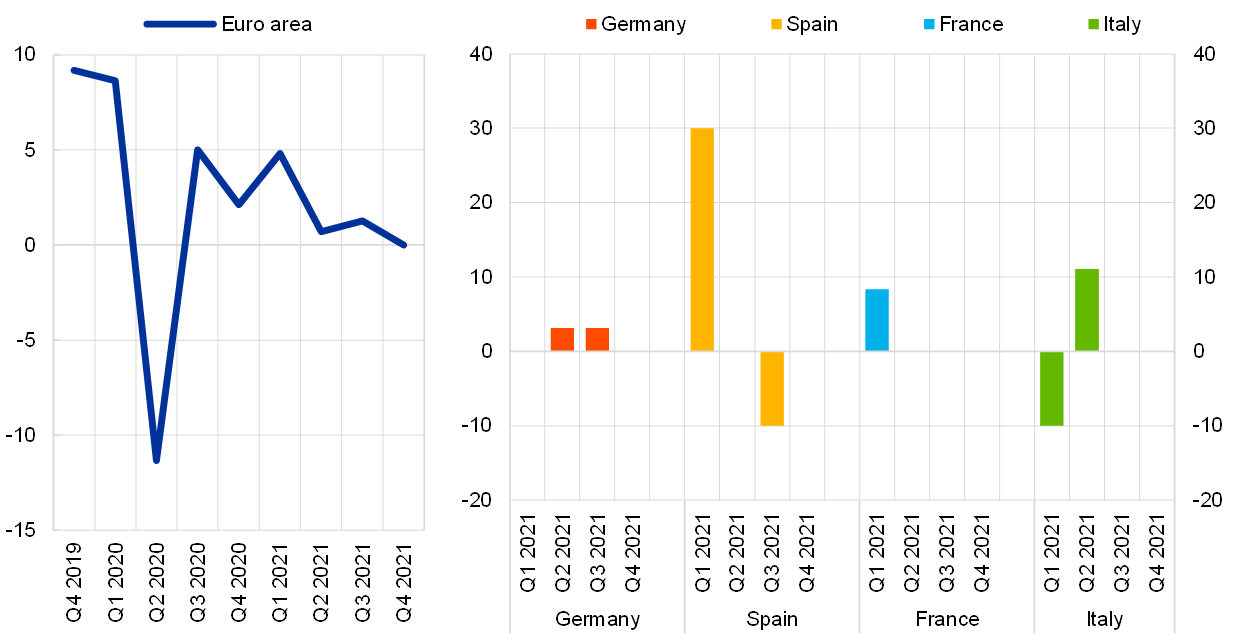
Notes: The net percentages for rejected loan applications are defined as the difference between the percentage of banks reporting an increase in the share of loan rejections and the percentage of banks reporting a decrease. Banks’ responses refer to the share of rejected loan applications relative to the total volume of applications in that loan category.
2.1.4 Net demand for loans to enterprises increased considerably
Banks reported a considerable net increase in firms’ demand for loans or credit lines in the fourth quarter of 2021 (net percentage of banks of 18%, after 8% in the third quarter of 2021[5]; see Chart 4 and Overview table). This is the strongest increase since the extraordinarily high increase in loan demand from firms in the first half of 2020. Similar net percentage increases of loan demand to firms occurred between the end of 2014 and mid-2018, broadly in line with the recovery of bank lending to euro area firms before the moderation of euro area economic activity in 2018-2019. Developments are in line with the recent increase in actual lending to euro area firms across maturities. Loan demand increased on balance for short-term loans (net percentage of 12%) and for long-term loans (15%). In addition, loan demand picked up for both SMEs (16%) and large firms (20%).
Loan demand was mainly driven by firms’ financing needs for working capital, but also for fixed investment, which picked up significantly (see Chart 4 and Table 4). These developments are consistent with the net increase in demand for short-term and long-term loans reported by banks and the pick-up in actual lending to euro area firms across maturities. While the net increase in financing needs for working capital is likely related to the current pandemic situation, production delays and the rebuilding of inventories resulting from supply bottlenecks, firms’ loan demand for fixed investment provides an overall positive sign for the economic recovery, despite the dampening impact of the pandemic.
In addition, banks continued to report a positive impact on loan demand from other financing needs, which include M&A activity and debt refinancing and restructuring, as well as, to a smaller extent, from the low general level of interest rates. By contrast, the impact of alternative financing sources, covering both internal and external sources of financing, was broadly neutral in the fourth quarter of 2021.
Chart 4
Changes in demand for loans or credit lines to enterprises, and contributing factors
(net percentages of banks reporting an increase in demand, and contributing factors)

Notes: “Actual” values are changes that have occurred, while “expected” values are changes anticipated by banks. Net percentages for the questions on demand for loans are defined as the difference between the sum of the percentages of banks responding “increased considerably” and “increased somewhat” and the sum of the percentages of banks responding “decreased somewhat” and “decreased considerably”. The net percentages for responses to questions relating to contributing factors are defined as the difference between the percentage of banks reporting that the given factor contributed to increasing demand and the percentage reporting that it contributed to decreasing demand. “Other financing needs” is the unweighted average of “mergers/acquisitions and corporate restructuring” and “debt refinancing/restructuring and renegotiation”; “use of alternative finance” is the unweighted average of “internal financing”, “loans from other banks”, “loans from non-banks”, “issuance/redemption of debt securities” and “issuance/redemption of equity”.
Table 4
Factors contributing to changes in demand for loans or credit lines to enterprises
(net percentages of banks)

Note: See the notes on Chart 4.
In the largest euro area countries, banks reported a net increase in demand for loans to firms in Germany, France and Italy, while loan demand remained unchanged in Spain. Financing needs for fixed investment had a positive impact on loan demand in all large euro area countries. For working capital, the impact was positive in most of the large countries, except for Spain. In addition, other financing needs, mostly driven by M&A activities, contributed positively to loan demand in Germany, Spain and France, while the impact was neutral for Italy.
In the first quarter of 2022, euro area banks expect a continued net increase in demand for loans to firms (net percentage of banks at 8%), with a somewhat larger increase in demand from SMEs (net percentage of 10%, compared with 6% for loans to large firms).
2.2 Loans to households for house purchase
2.2.1 Credit standards for loans to households for house purchase were unchanged
In the fourth quarter of 2021, euro area banks reported unchanged credit standards for loans to households for house purchase (net percentage of banks at 0%; see Chart 5 and Overview table), following a slight net tightening of credit standards (2%) in the previous quarter of 2021.[6]
Chart 5
Changes in credit standards applied to the approval of loans to households for house purchase, and contributing factors
(net percentages of banks reporting a tightening of credit standards, and contributing factors)
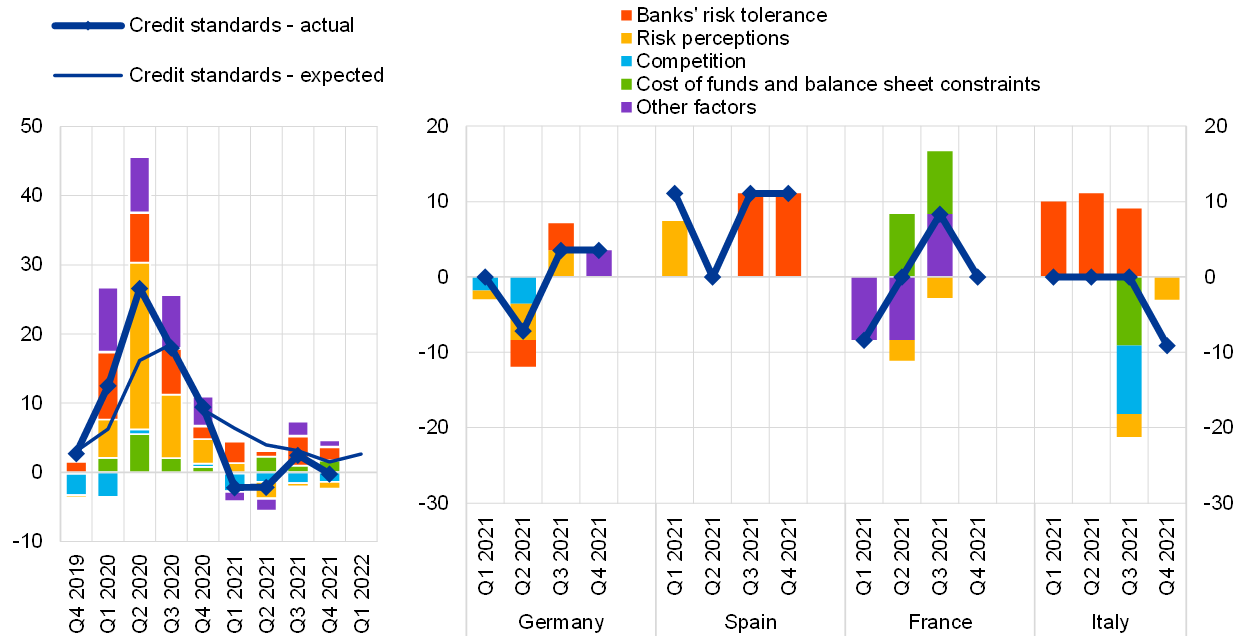
Notes: See the notes on Chart 1. “Risk perceptions” is the unweighted average of “general economic situation and outlook”, “housing market prospects, including expected house price developments” and “borrower’s creditworthiness”; “competition” is the unweighted average of “competition from other banks” and “competition from non-banks”. The net percentages for “other factors” refer to further factors which were mentioned by banks as having contributed to changes in credit standards, currently mainly related to macroprudential policy recommendations.
Banks’ lower risk tolerance as well as their cost of funds and balance sheet situation had a small net tightening impact (see Chart 5 and Table 5). At the same time, banks’ risk perceptions related to the economic outlook had a small easing impact, whereas risk perceptions related to housing market prospects and the creditworthiness of borrowers had a neutral impact on credit standards. This highlights that, despite the Omicron variant, banks are still positive about the economic outlook. Finally, competition from banks and non-banks had a broadly neutral impact on loans to households for house purchase.
Across the largest euro area countries, credit standards have tightened in net terms in Germany and Spain, eased in Italy and remained unchanged in France. There was a tightening impact of banks’ risk tolerance in Spain, whereas this factor had a neutral effect on credit standards in Germany, France and Italy. Banks in Italy indicated that the net easing of credit standards for loans to households for house purchase was driven by an improvement in risk perceptions related to the economic outlook. In Germany, other factors related to the implementation of the EBA guidelines on loan origination and monitoring had a tightening impact on credit standards.
In the first quarter of 2022, euro area banks expect a moderate net tightening of credit standards on loans to households for house purchase (net percentage of banks of 3%).
Table 5
Factors contributing to changes in credit standards for loans to households for house purchase
(net percentages of banks)

Note: See the notes on Chart 5.
2.2.2 Terms and conditions on loans to households for house purchase were broadly unchanged
Banks reported on balance broadly unchanged overall terms and conditions for housing loans (net percentage of banks of -1%, after 0% in the previous quarter; see Chart 6 and Table 6).[7] This follows a net easing in overall terms and conditions in the first half of 2021 and unchanged terms and conditions reported by banks in the previous survey round. In line with lending rates being close to historically low levels, banks continued to report in net terms a narrowing of margins for average loans. At the same time, banks reported a small net tightening impact of loan-to-value ratios and a moderate net tightening impact for margins on riskier loans.
Chart 6
Changes in terms and conditions on loans to households for house purchase
(net percentages of banks reporting a tightening of terms and conditions)
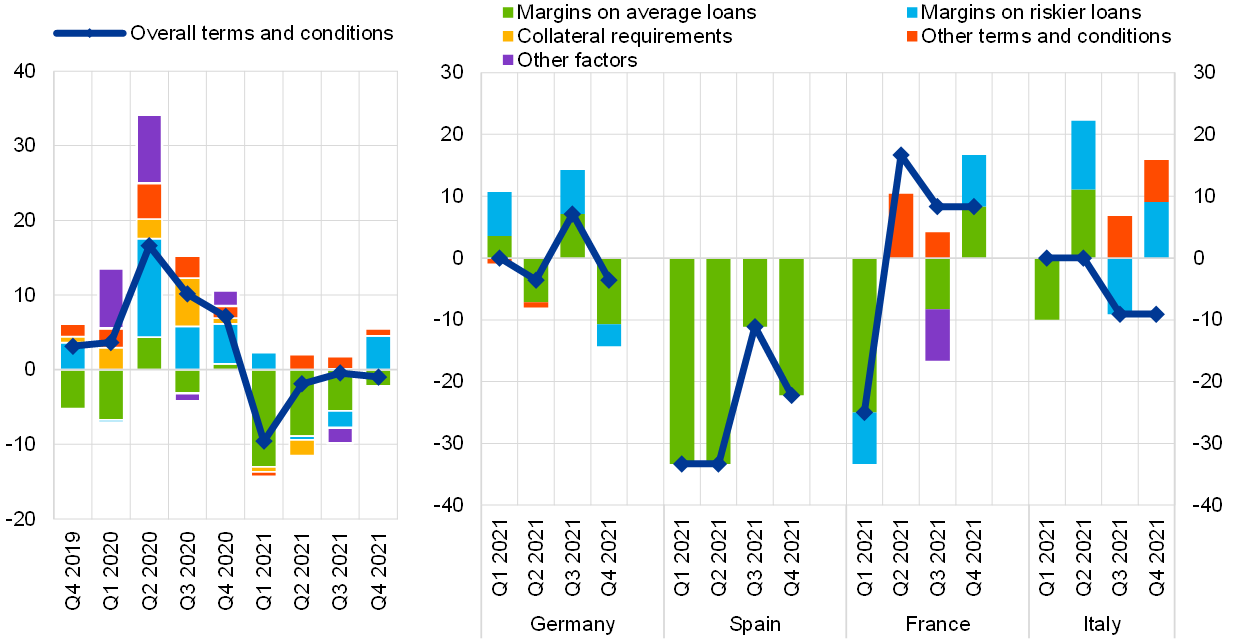
Notes: “Margins” are defined as the spread over a relevant market reference rate. “Other terms and conditions” is the unweighted average of “loan-to-value ratio”, “other loan size limits”, “non-interest rate charges” and “maturity”. The net percentages for “other factors” refer to further factors which were mentioned by banks as having contributed to changes in terms and conditions.
Table 6
Changes in terms and conditions on loans to households for house purchase
(net percentages of banks)

Note: See the notes on Chart 6.
Cost of funds and balance sheet constraints contributed moderately to a tightening of terms and conditions, and risk perceptions and risk tolerance also had a slight net tightening impact (see Table 7). By contrast, banks indicated a net easing impact from competitive pressures.
In the largest euro area countries, overall terms and conditions for housing loans have eased in net terms in Germany, Spain and Italy, and tightened in France. This was driven by a narrowing of margins on average loans in Germany and Spain and by a narrowing of margins on riskier loans in Germany, mostly related to pressure from competition. At the same time, banks in France reported a widening of all margins, related to costs of funds and balance sheet constraints, whereas banks in Italy indicated a widening of margins on riskier loans and unchanged margins on average loans related to various factors.
Table 7
Factors contributing to changes in overall terms and conditions on loans to households for house purchase
(net percentages of banks)

Note: The net percentages for these questions relating to contributing factors are defined as the difference between the percentage of banks reporting that the given factor contributed to a tightening and the percentage reporting that it contributed to an easing.
2.2.3 Rejection rate for housing loans increased slightly
In the fourth quarter of 2021, euro area banks continued to report a small net increase in the share of rejected applications for housing loans, following a stronger net increase, particularly in the second quarter of 2021 (2%, after 3% in the previous quarter; see Chart 7).
Chart 7
Changes in the rejection rate for loans to households for house purchase
(net percentages of banks reporting an increase in the share of rejections)
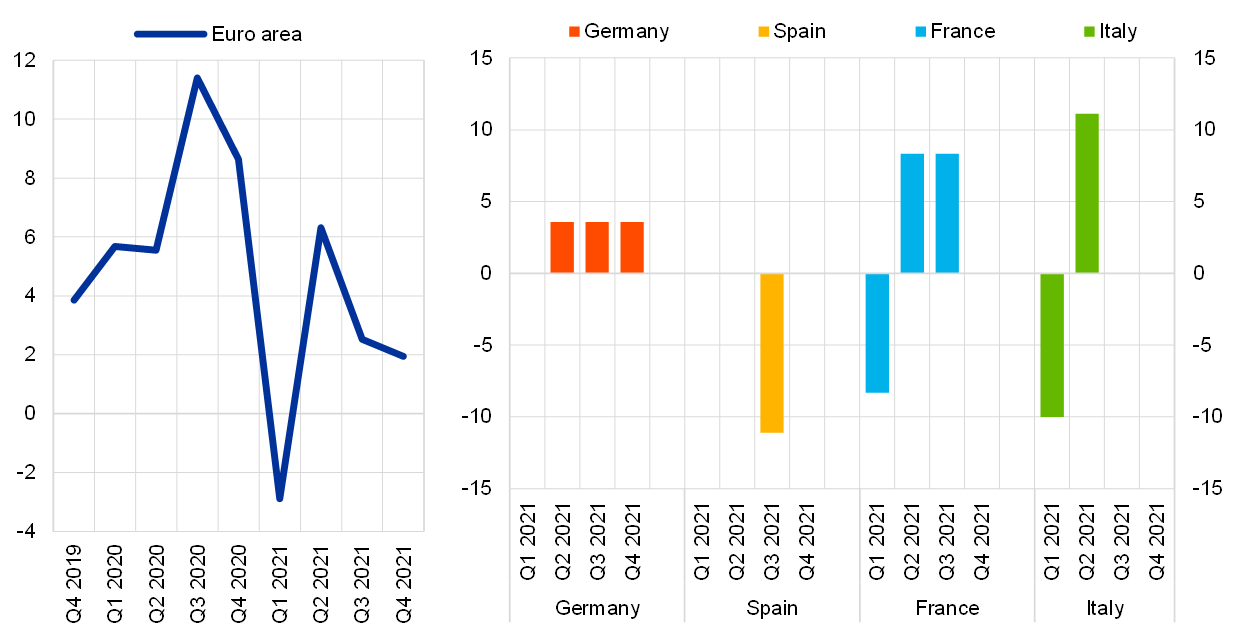
Notes: Net percentages for rejected loan applications are defined as the difference between the percentage of banks reporting an increase in the share of loan rejections and the percentage of banks reporting a decrease. Banks’ answers refer to the share of rejected loan applications relative to the total volume of applications in that loan category.
Across the largest euro area countries, the rejection rate for housing loans has moderately increased in Germany, whereas it remained unchanged in Spain, France and Italy.
2.2.4 Net demand for housing loans increased
Banks reported, in net terms, a continued robust increase in demand for housing loans in the fourth quarter of 2021 (net percentage of banks of 8%, after 11% in the third quarter of 2021; see Chart 8 and Overview table). This development is in line with observed dynamic lending for house purchase.
According to BLS evidence, consumer confidence remained supportive of housing loan demand in the fourth quarter of 2021, but less than in the previous two quarters (see Chart 8 and Table 8). This is broadly consistent with the European Commission’s consumer sentiment indicator, which declined in the fourth quarter of 2021, reflecting the reintroduction of containment measures in some euro area countries and the uncertainties surrounding the Omicron variant, while it was still above its long-term average. In addition, the low general level of interest rates and housing market prospects continued to support the demand for loans to households for house purchase, with the euro area housing market remaining resilient during most of the COVID-19 pandemic. Loan demand was also supported by other financing needs related to the regulatory and fiscal regime. By contrast, loans from other banks, as a source of alternative finance, had a dampening impact on housing loan demand in the fourth quarter of 2021.
Chart 8
Changes in demand for loans to households for house purchase, and contributing factors
(net percentages of banks reporting an increase in demand, and contributing factors)
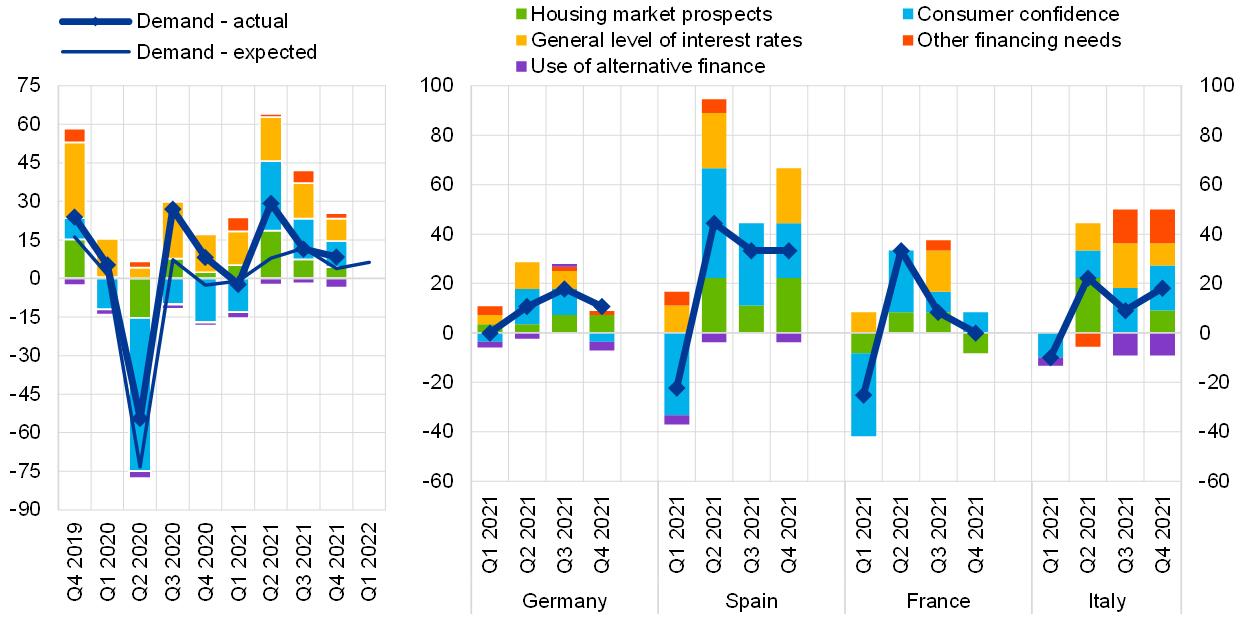
Notes: See the notes on Chart 4. “Other financing needs” is the unweighted average of “debt refinancing/restructuring and renegotiation” and “regulatory and fiscal regime of housing markets”; “use of alternative finance” is the unweighted average of “internal finance of house purchase out of savings/down payment”, “loans from other banks” and “other sources of external finance”.
Across the largest euro area countries, banks in Germany, Spain and Italy reported a net increase in housing loan demand in the fourth quarter of 2021, whereas banks in France reported unchanged demand for housing loans. Consumer confidence, housing market prospects and the low general level of interest rates contributed to the net increase in demand for loans for house purchase in Spain and Italy. Housing market prospects also played a positive role in housing loan developments in Germany, and consumer confidence in France. At the same time, the use of alternative finance related to loans from other banks had a dampening impact in Germany, Spain and Italy whereas other financing needs related to the regulatory and fiscal regime had a positive effect for loans to households for house purchase in Italy.
In the fourth quarter of 2021, banks expect a continued net increase in the demand for housing loans (net percentage of banks of 6%).
Table 8
Factors contributing to changes in demand for loans to households for house purchase
(net percentages of banks)

Note: See the notes on Chart 8.
2.3 Consumer credit and other lending to households
2.3.1 Credit standards for consumer credit and other lending to households eased moderately
Banks reported a moderate net easing for credit standards for consumer credit and other lending to households in the fourth quarter of 2021 (net percentage of -4%; see Chart 9 and Overview table), following a moderate net easing (-3%) of credit standards in the previous BLS round.[8]
The increased risk tolerance of banks and cost of funds contributed to the net easing in credit standards (see Chart 9 and Table 9). In addition, risk perceptions related to the economic outlook and the creditworthiness of borrowers continued to have an easing impact. At the same time, competition from other banks had a broadly neutral impact.
Across the largest euro area countries, credit standards for consumer credit and other lending to households eased in Italy and France, supported by increased risk tolerance and risk perceptions related to the economic outlook. In addition, the costs of funds had an easing impact for banks in France, while competition from other banks had an easing impact in Italy. At the same time, banks in Spain reported a net tightening on account of decreased risk tolerance. Banks in Germany reported unchanged credit standards.
In the first quarter of 2022, euro area banks expect a further net easing in credit standards for consumer credit and other lending to households (net percentage of -6%).
Chart 9
Changes in credit standards applied to the approval of consumer credit and other lending to households, and contributing factors
(net percentages of banks reporting a tightening of credit standards, and contributing factors)
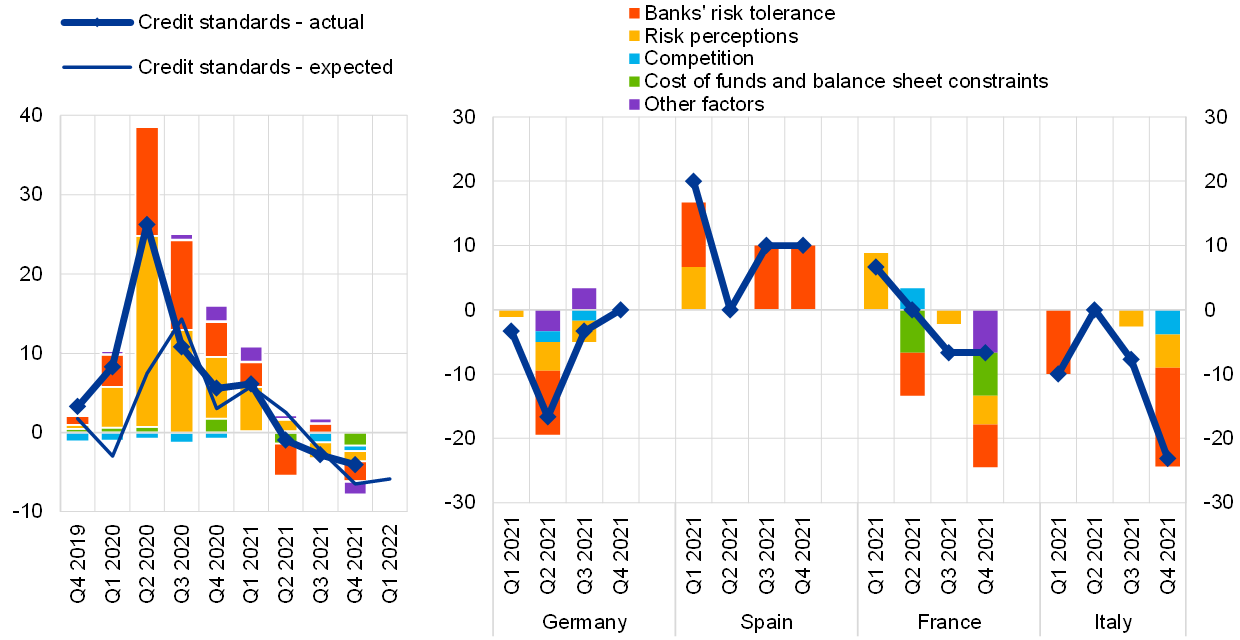
Notes: See the notes on Chart 1. “Risk perceptions” is the unweighted average of “general economic situation and outlook”, “creditworthiness of consumers” and “risk on the collateral demanded”; “competition” is the unweighted average of “competition from other banks” and “competition from non-banks”. The net percentages for “other factors” refer to further factors which were mentioned by banks as having contributed to changes in credit standards.
Table 9
Factors contributing to changes in credit standards for consumer credit and other lending to households
(net percentages of banks)

Note: See the notes on Chart 9.
2.3.2 Terms and conditions on consumer credit and other lending to households remained broadly unchanged
In the fourth quarter of 2021, banks’ overall terms and conditions applied when granting consumer credit and other lending to households remained broadly unchanged (net percentage of -1%, after 0% in the previous quarter; see Chart 10 and Table 10), with margins on average and riskier loans having a broadly neutral impact.
Chart 10
Changes in terms and conditions on consumer credit and other lending to households
(net percentages of banks reporting a tightening of terms and conditions)
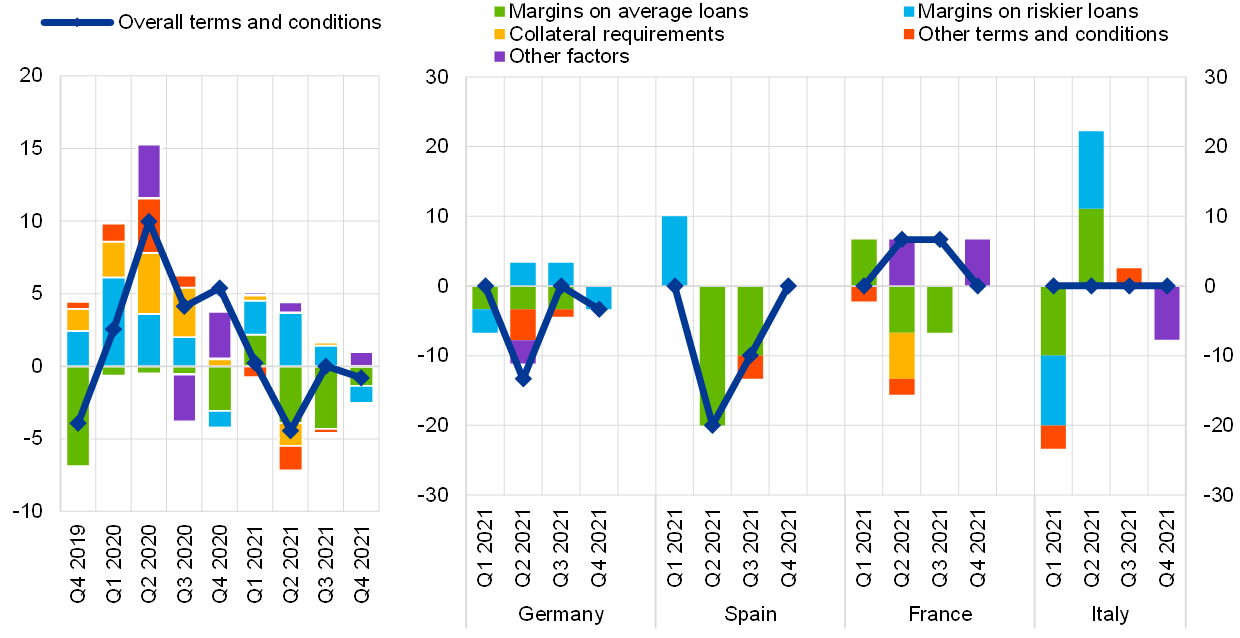
Notes: “Margins” are defined as the spread over a relevant market reference rate. “Other terms and conditions” is the unweighted average of “size of the loan”, “non-interest rate charges” and “maturity”. The net percentages for “other factors” refer to further factors which were mentioned by banks as having contributed to changes in terms and conditions.
Table 10
Changes in terms and conditions on consumer credit and other lending to households
(net percentages of banks)

Note: See the notes on Chart 10.
Pressure from competition continued to have, on balance, an easing impact on banks’ overall terms and conditions for consumer credit (see Table 11). By contrast, banks’ costs of funds and balance sheet constraints and risk perceptions had a small net tightening impact.
Across the largest euro area countries, overall terms and conditions on consumer credit and other lending to households eased in net terms in Germany on account of narrowing margins on riskier loans due to the easing impact of competition, whereas they remained unchanged in Spain, France and Italy.
Table 11
Factors contributing to changes in overall terms and conditions on consumer credit and other lending to households
(net percentages of banks)
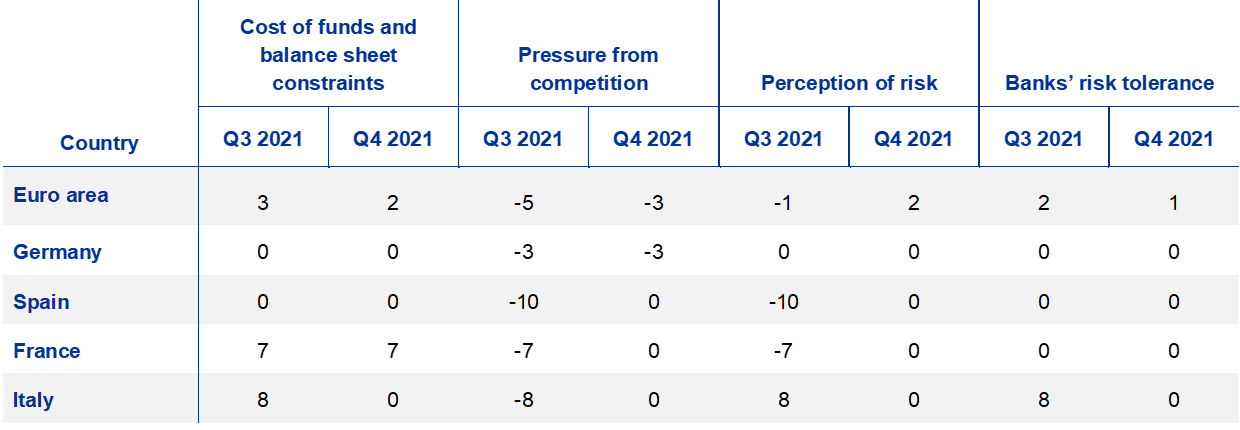
Note: The net percentages for these questions relating to contributing factors are defined as the difference between the percentage of banks reporting that the given factor contributed to a tightening and the percentage reporting that it contributed to an easing.
2.3.3 Rejection rate for consumer credit and other lending to households decreased
In the fourth quarter of 2021, euro area banks reported a moderate net decrease in the share of rejected applications for consumer credit and other lending to households (-3%, after -2% in the previous survey round; see Chart 11). This is consistent with the reported easing in credit standards for consumer credit and other lending to households in the fourth quarter of 2021.
Across the largest euro area countries, the rejection rate decreased on balance in France and Italy, whereas it was unchanged in Germany and Spain.
Chart 11
Changes in the rejection rate for consumer credit and other lending to households
(net percentages of banks reporting an increase in the share of rejections)
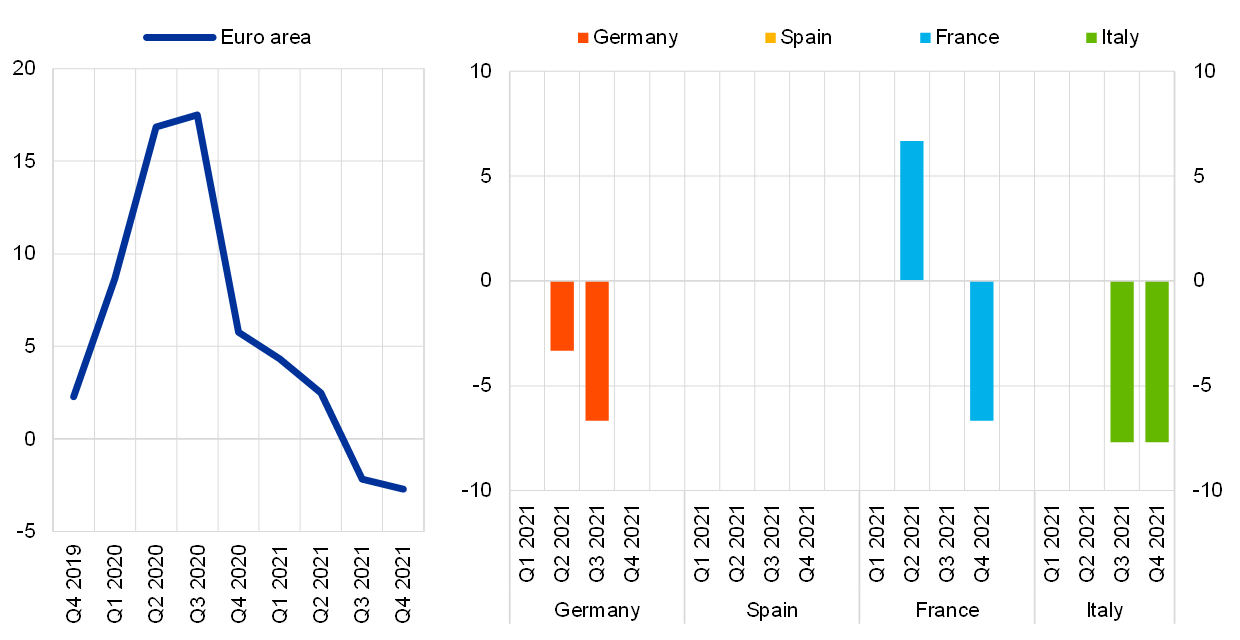
Notes: Net percentages for rejected loan applications are defined as the difference between the percentage of banks reporting an increase in the share of loan rejections and the percentage of banks reporting a decrease. Banks’ responses refer to the share of rejected loan applications relative to the total volume of applications in that loan category.
2.3.4 Net demand for consumer credit and other lending to households increased slightly
In the fourth quarter of 2021, banks reported a small net increase in demand for consumer credit and other lending to households (net percentage of banks at 2%, after 5% in the previous quarter; see Chart 12 and Overview table), following similar developments in the previous quarter.[9] This is broadly in line with the moderate consumer credit growth observed recently, albeit remaining weak overall.
Consumer confidence continued to have a positive impact on demand for consumer credit, although more moderate than in the previous quarter (see Chart 12 and Table 12). This is broadly in line with the recent decline in the European Commission’s consumer confidence indicator, reflecting the emergence of the Omicron variant and related containment measures introduced in some countries at the end of 2021. In addition, the low general level of interest rates had a small positive impact on demand for consumer credit, whereas the use of internal finance out of savings and loans from other banks, summarised in the use of alternative finance, had a negative impact. Spending on durables also had a negative effect on the demand for consumer credit and other lending to households.
Chart 12
Changes in demand for consumer credit and other lending to households, and contributing factors
(net percentages of banks reporting an increase in demand, and contributing factors)
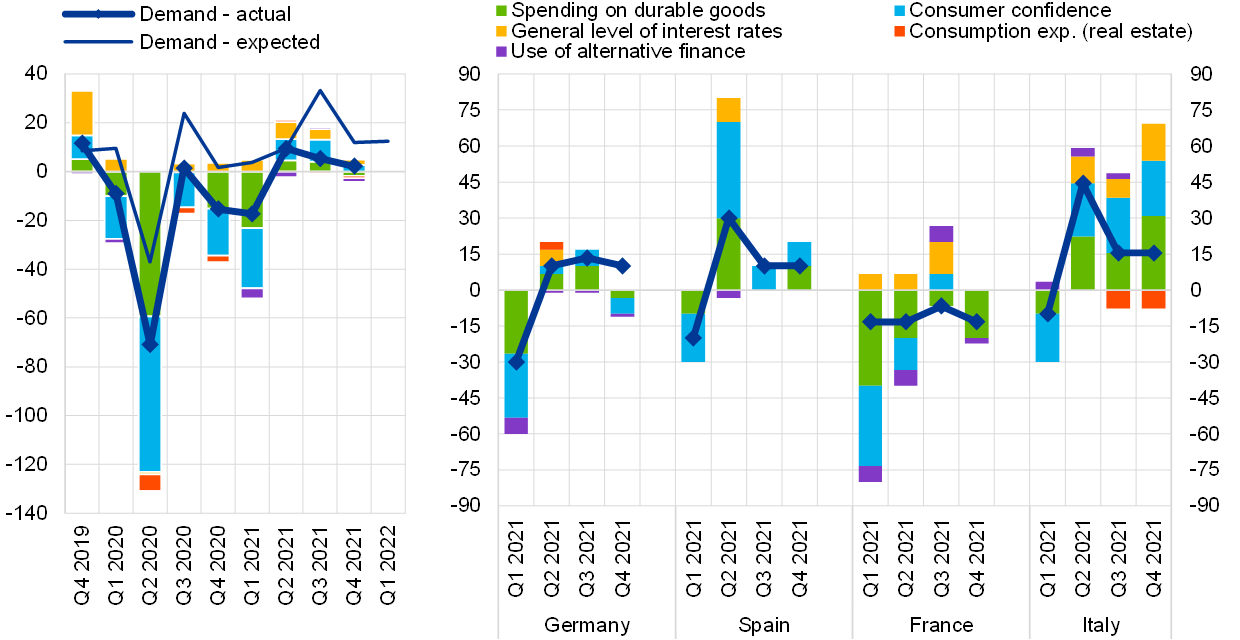
Notes: See the notes on Chart 4. “Use of alternative finance” is the unweighted average of “internal financing out of savings”, “loans from other banks” and “other sources of external finance”. “Consumption exp. (real estate)” denotes “consumption expenditure financed through real estate-guaranteed loans”.
Across the largest euro area countries, banks in Germany, Spain and Italy continued to report a net increase in demand for consumer credit. Higher consumer confidence and spending on durables explained the net increase in demand in Spain and Italy, whereas the low general level of interest rates also contributed to the increase in net demand in Italy. In France, the net demand for consumer credit and other lending to households decreased, on account of decreased spending on durables and to a smaller extent related to the use of internal finance out of savings.
In the first quarter of 2022, banks expect a net increase in demand for consumer credit and other lending to households (net percentage of 12%).
Table 12
Factors contributing to changes in demand for consumer credit and other lending to households
(net percentages of banks)

Note: See the notes on Chart 12.
3 Ad hoc questions
3.1 Banks’ access to retail and wholesale funding
The January 2022 survey included a question asking banks to assess the extent to which the situation in the financial markets has affected their access to retail and wholesale funding.
Chart 13
Banks’ assessment of funding conditions and the ability to transfer credit risk off the balance sheet
(net percentages of banks reporting a deterioration in market access)

Note: The net percentages are defined as the difference between the sum of the percentages of banks responding “deteriorated considerably” and “deteriorated somewhat” and the sum of the percentages of banks responding “eased somewhat” and “eased considerably”.
Table 13
Banks’ assessment of funding conditions and the ability to transfer credit risk off the balance sheet
(net percentages of banks reporting a deterioration in market access)

Note: See the notes on Chart 13.
In the fourth quarter of 2021, euro area banks reported that their access to retail funding continued to improve in net terms, although the improvement was more moderate than in the previous quarter (net percentage of banks of -5%, after -8% in Q3 2021; see Chart 13). At the same time, access to money markets, to funding via debt securities and securitisation was broadly unchanged in the fourth quarter of 2021. For retail funding, the improvement was driven by short-term deposit funding, whereas the positive impact of long-term deposits was much smaller. This is in line with the observed developments in deposits, which continue to expand, albeit at a slower pace for households compared with 2020, in the context of increased private consumption and decreasing real returns.
Looking ahead to the first quarter of 2022, euro area banks expect a slight improvement in their access to retail funding and debt securities, while they expect access to money markets and securitisation to remain broadly unchanged.
3.2 Banks’ adjustment to regulatory and supervisory action
The January 2022 BLS questionnaire included an annual[10] ad-hoc question to assess the extent to which new regulatory or supervisory requirements affected banks’ lending policies via the potential impact on their capital, leverage, liquidity position or provisioning and the credit conditions that they apply to loans. These new requirements cover regulatory or supervisory action that have been implemented recently or that are expected to be implemented in the near future. Furthermore, banks were also asked to indicate the effects on their funding conditions.
Chart 14
Impact of regulatory or supervisory action on banks’ risk-weighted assets, capital and funding conditions
(net percentages of banks)
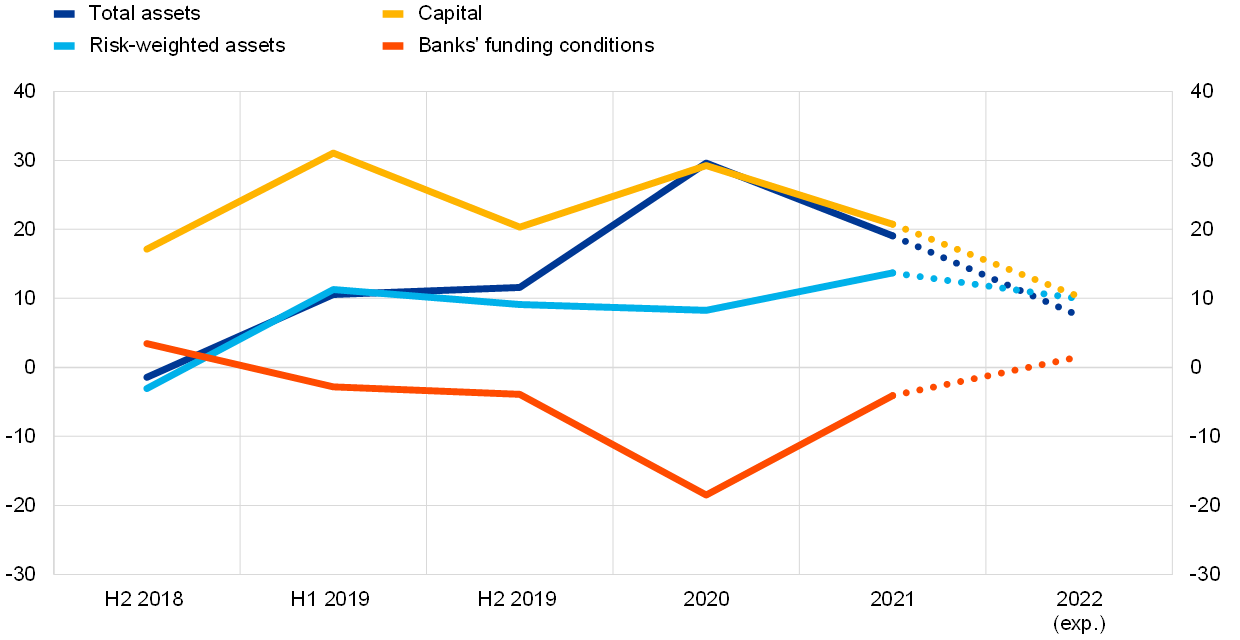
Notes: For “total assets”, “risk-weighted assets” and “capital”, the net percentages are defined as the difference between the sum of the percentages of banks responding “increased considerably” and “increased somewhat” and the sum of the percentages for “decreased somewhat” and “decreased considerably”. For “banks’ funding conditions”, the net percentages are defined as the difference between the sum of the percentages of banks responding “experienced a considerable tightening” and “experienced a moderate tightening” and the sum of the percentages for “experienced a moderate easing” and “experienced a considerable easing”.
Euro area banks reported a continued strengthening of their capital position in 2021 in response to new regulatory or supervisory requirements (see Chart 14 and Table 14), with the strengthening being driven more by retained earnings than by capital issuance. Banks indicated that regulatory or supervisory measures implemented in the context of the COVID-19 pandemic also led to an increase in their total assets, although to a smaller extent than indicated for the year 2020. Changes in total assets for euro area banks were driven by liquid assets, reflecting banks’ high excess liquidity holdings. Risk-weighted assets also continued to increase, on account of an increase in average loans, while the contribution of riskier loans was much more dampened. At the same time, banks indicated that regulatory or supervisory action had a moderate easing impact on their funding conditions.
Table 14
Impact of regulatory or supervisory action on banks’ risk-weighted assets, capital and funding conditions
(net percentages)

Note: See the notes to Chart 14.
Supervisory or regulatory action had a net tightening impact on banks’ credit standards on loans to large firms, on consumer credit and in particular on loans for house purchase in 2021 (see Chart 15 and Table 15). The impact of supervisory or regulatory action was broadly neutral for loans to SMEs. The relatively stronger tightening impact on loans to households for house purchase was probably related to macroprudential measures on housing markets in some countries and was larger than had been reported for 2020. Concerning credit margins, banks reported a small tightening impact of supervisory and regulatory measures for loans to large firms and consumer credit, and a broadly neutral impact on credit margins on loans to SMEs and loans to households for house purchase.
Chart 15
Contribution of regulatory or supervisory action to the tightening of banks’ credit standards and margins
(net percentages of banks)
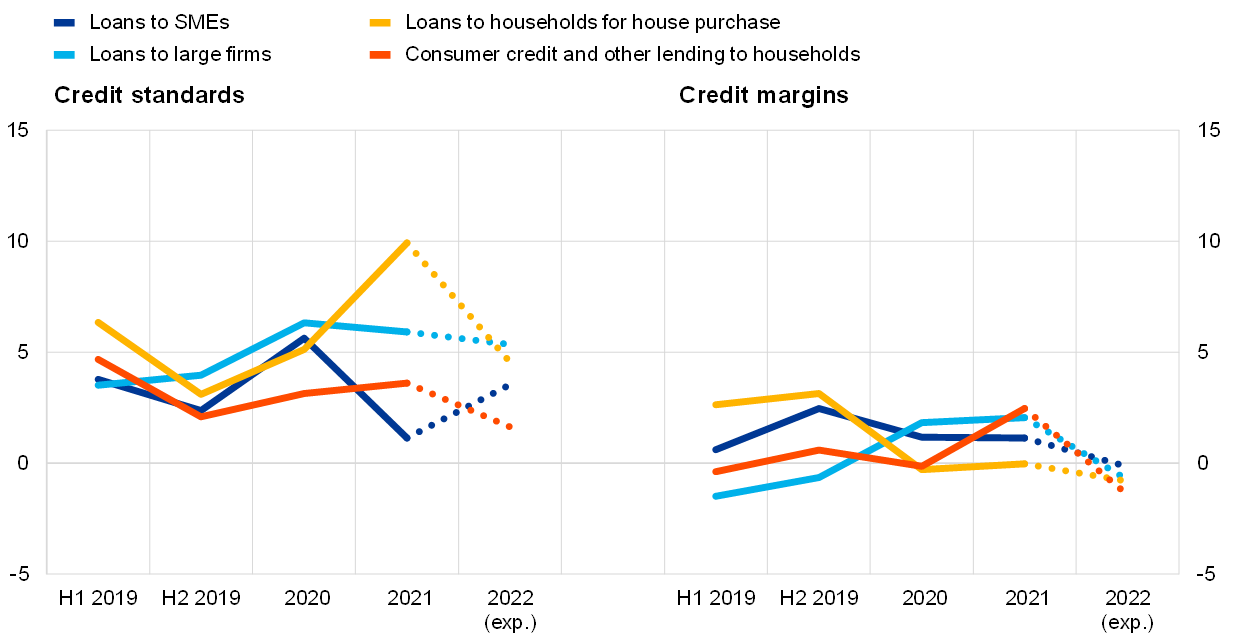
Notes: The net percentages are defined as the difference between the sum of the percentages of banks responding “tightened considerably” and “tightened somewhat” and the sum of the percentages of banks responding “eased somewhat” and “eased considerably”.
Looking ahead to 2022, euro area banks expect regulatory or supervisory action to support their capital positions and lead to an increase in their total assets and risk-weighted assets, although to a smaller extent than in 2021. In addition, for their funding conditions, banks expect a small net tightening impact. Banks also expect regulatory or supervisory action to have a moderate net tightening impact for credit standards on loans to firms and house purchase loans, and a slight net tightening impact on consumer credit. Finally, banks expect regulatory or supervisory action to have a broadly neutral impact on credit margins across all loan categories.
Table 15
Contribution of regulatory or supervisory action to the tightening of banks’ credit standards and margins
(net percentages)

Note: See the notes to Chart 15.
3.3 The impact of banks’ NPL ratios on their lending policies
The January 2022 survey questionnaire included a biannual ad hoc question on the impact of banks’ non-performing loan (NPL) ratios on changes in their lending policies and the factors through which NPL ratios contributed to changes in their lending policies. Banks were asked about the impact on loans to enterprises, loans to households for house purchase and on consumer credit and other lending to households over the past six months and over the next six months.
Euro area banks reported a small net tightening impact of their NPL ratios on credit standards for loans to enterprises in the second half of 2021 (net percentage of 2%, after 4% in the first half of 2021; see Chart 16) and for consumer credit (2%, after 1%), whereas the impact continued to be neutral on credit standards for loans to households for house purchase in the second half of 2021 (0%, after 0%). Following a small tightening effect on terms and conditions for loans to firms and neutral impact on all loans to households in the first half of 2021, banks reported that NPL ratios had a broadly neutral effect on terms and conditions for loans to firms (-1%, after 3%) and consumer credit (0%, after 0%), and a small easing impact on conditions for housing loans (-2%, after 0%) in the second half of 2021 (see Chart 16). The small net tightening impact of NPL ratios on credit standards across all loan categories was in line with the expectations from the survey results in the previous round and the observed further decline in NPLs in banks’ household and firm exposures.
Banks referred to pressure related to supervisory or regulatory requirements as well as decreased risk tolerance contributing to a small net tightening impact of NPL ratios on lending conditions in the second half of 2021 (see Chart 17). At the same time, costs related to banks’ capital position and balance sheet clean-up operations, banks’ access to market financing and their liquidity position continued to have a broadly neutral impact on lending conditions. While banks’ risk perception had contributed to a tightening impact of NPL’s on lending conditions in the first half of 2021, its impact was neutral in the current BLS round.
Chart 16
Impact of banks’ NPL ratios on credit standards and terms and conditions
(net percentages of banks)

Notes: The NPL ratio is defined as the stock of gross NPLs on a bank’s balance sheet as a percentage of the gross carrying amount of loans. Changes in credit standards and/or terms and conditions can be caused by changes to the NPL ratio or by changes to regulations or the bank’s assessment of the level of the NPL ratio. Net percentages are defined as the difference between the sum of the percentages of banks responding “contributed considerably to tightening” and “contributed somewhat to tightening” and the sum of the percentages of banks responding “contributed somewhat to easing” and “contributed considerably to easing”. The diamonds denote expectations indicated by banks in the current round.
Over the next six months, euro area banks expect NPL ratios to have a broadly neutral impact on credit standards across all loan categories and on terms and conditions for loans to firms and housing loans, whereas NPL ratios are expected to have a slight easing impact on terms and conditions for consumer credit. Pressures related to supervisory or regulatory requirements and banks’ lower risk tolerance are expected to have a tightening impact on lending policies with net percentages remaining at similar levels as over the past six months. In addition, costs related to the capital position of banks are also expected to have a small tightening impact. At the same time, costs related to banks’ balance sheet clean-up operations are expected to have a slight easing effect.
Chart 17
Contributions of factors through which NPL ratios affect banks’ policies on lending to enterprises and households
(net percentages of banks)
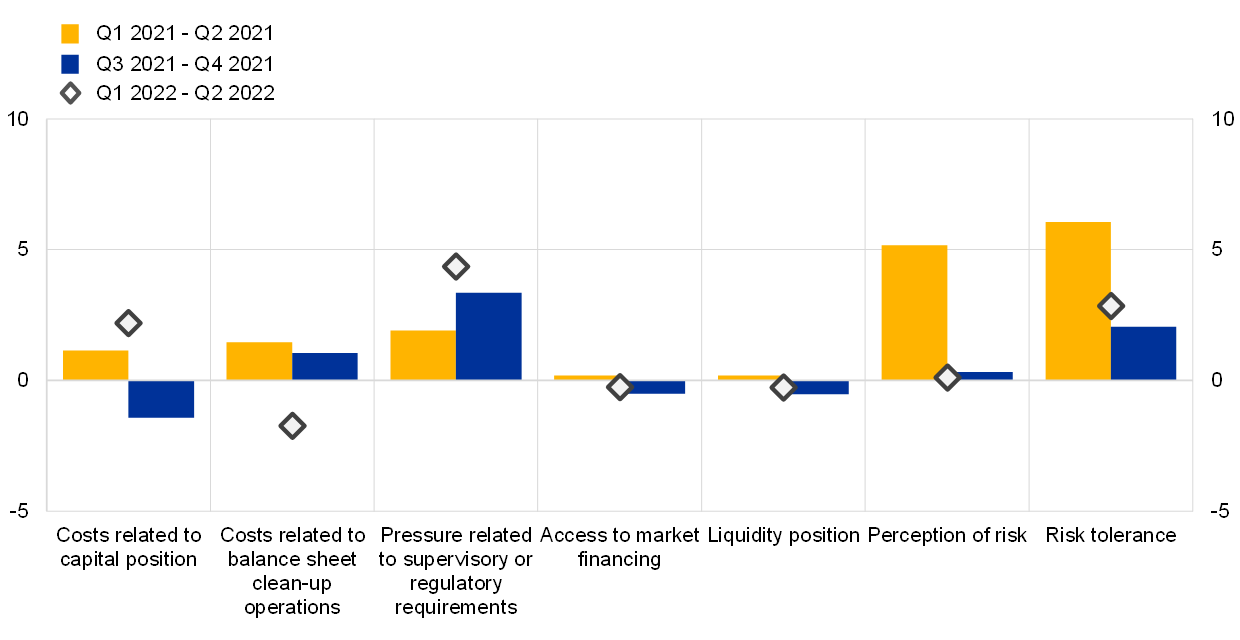
Note: See the notes on Chart 16.
3.4 Bank lending conditions and loan demand across main sectors of economic activity
The January 2022 survey questionnaire included a biannual ad hoc question to collect information on changes in banks’ credit standards, overall terms and conditions and loan demand across the main economic sectors over the past and next six months. Banks were asked to provide information covering five sectors: manufacturing, construction (excluding real estate), services (excluding financial services and real estate), wholesale and retail trade, and real estate (including both real estate construction and real estate services).
Euro area banks indicated a moderate net tightening or broadly unchanged credit standards for new loans to enterprises across the main economic sectors in the second half of 2021 (see Chart 18). Developments for credit standards are in line with broadly unchanged credit standards reported by banks for loans to all firms in the third quarter of 2021 and the slight net tightening of credit standards in the fourth quarter. The net tightening was most pronounced for loans to firms in the commercial real estate sector (net percentage for credit standards at 10%, after 4% in the first half of 2021), followed by wholesale and retail trade (6%, after 9%) and residential real estate (2%, after -1%). Following a net tightening in the first half of 2021, credit standards remained broadly unchanged for manufacturing (-1%, after 2%), construction (1%, after 3%) and services (-1%, after 7%). Banks’ overall terms and conditions tightened for commercial and residential real estate, wholesale and retail trade and construction, whereas they remained broadly unchanged for services and manufacturing (see Chart 19).
Over the next six months, euro area banks expect developments in credit standards for new loans to enterprises to be similar to the second half of 2021, namely a net tightening in wholesale and retail trade and real estate, broadly unchanged credit standards in construction and services and a small net easing in manufacturing. Regarding overall terms and conditions for new loans to firms in the first half of 2022, banks expect a small net tightening in construction, wholesale and retail trade and commercial real estate, a slight net easing in services and broadly unchanged lending conditions in manufacturing and residential real estate.
Chart 18
Changes in credit standards for new loans to enterprises across main economic sectors
(net percentages of banks; over the past six months and the next six months)
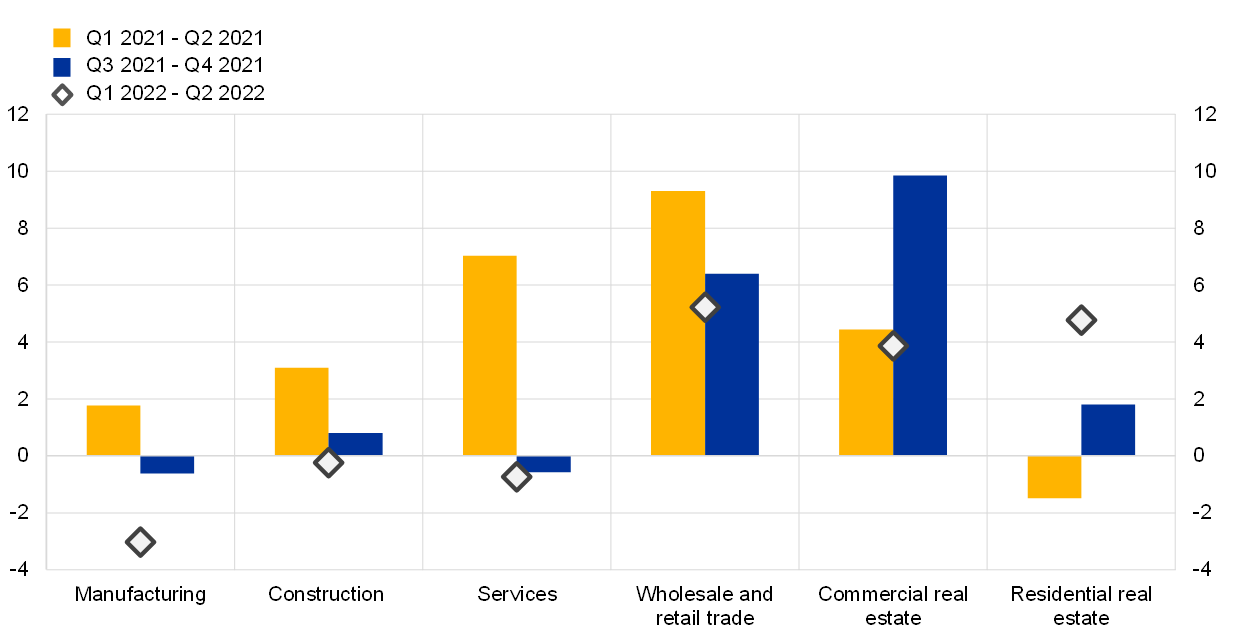
Notes: The net percentages refer to the difference between the sum of the percentages of banks responding “deteriorated considerably” and “deteriorated somewhat” and the sum of the percentages of banks responding “eased somewhat” and “eased considerably". The diamonds denote expectations indicated by banks in the current round.
Banks reported a net increase in the demand for loans or credit lines in all economic sectors, in line with the reported overall increase in demand for loans to firms in the third and fourth quarters of 2021 (see Chart 20). The net increase in demand was most pronounced in the commercial real estate, manufacturing and services sectors.
Over the next six months, euro area banks expect a continued net increase in demand from firms from all the main economic sectors.
Chart 19
Changes in terms and conditions for new loans to enterprises across main economic sectors
(net percentages of banks; over the past six months and the next six months)
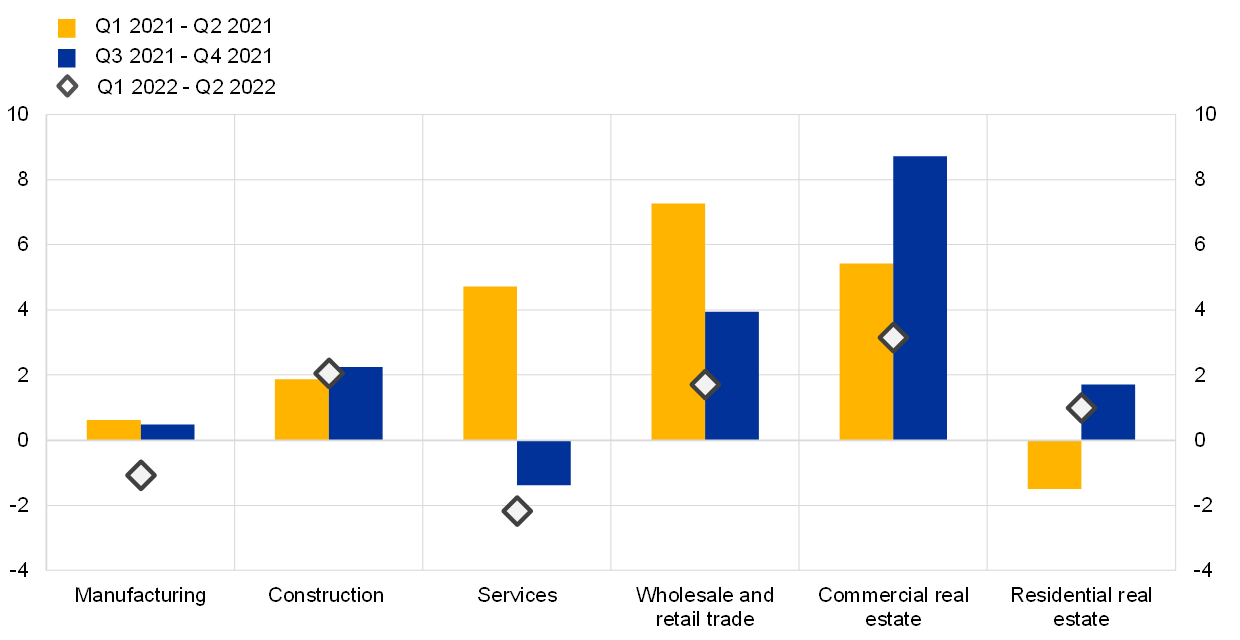
Note: See the notes on Chart 18.
Chart 20
Changes in demand for loans or credit lines to enterprises across main economic sectors
(net percentages of banks)
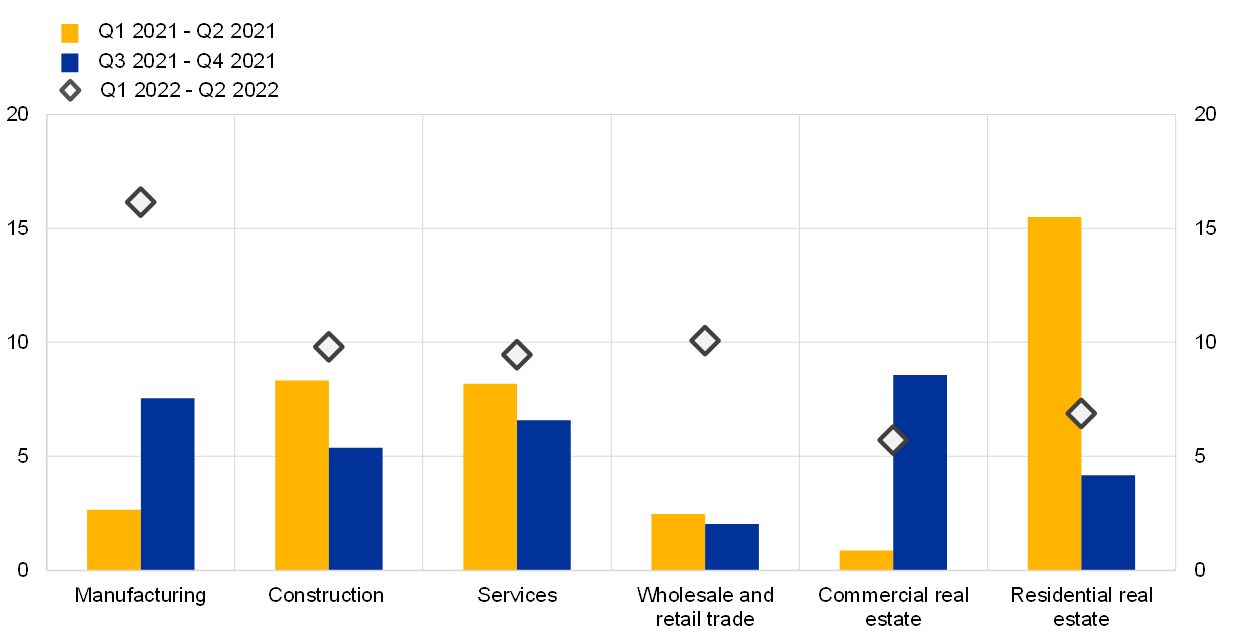
Notes: The net percentages refer to the difference between the sum of the percentages of banks responding “increased considerably” and “increased somewhat” and the sum of the percentages of banks responding “decreased somewhat” and “decreased considerably". The diamonds denote expectations indicated by banks in the current round.
3.5 The impact of government loan guarantees related to the COVID-19 pandemic
The January 2022 survey questionnaire included, for the third time since the start of the pandemic, a biannual ad hoc question to collect information on changes in banks’ lending conditions and demand for loans with COVID-19 related government guarantees and for loans without government guarantees over the past six months. In addition, banks were asked about the factors affecting demand for loans with COVID-19 related government guarantees.
Euro area banks reported that COVID-19 related government guarantees continued to support banks’ credit standards for loans to firms in the second half of 2021 (see Chart 21). Credit standards on loans to firms with COVID-19 related government guarantees eased over the past six months (net percentage of -3%, after -11% in the first half of 2021), more for loans to SMEs (-4%, after-11%) than for loans to large enterprises (-2%, after -7%), suggesting that SMEs in particular benefit from the government guarantees. For loans to enterprises without government guarantees, banks reported on balance a slight net tightening in credit standards in the second half of 2021 (net percentage of 3%, after -2% in the first half of 2021; see Chart 21). This reflected a slight net tightening of credit standards for loans to both SMEs (3%, after -2%) and large enterprises (2%, after -4%). As the take-up of loans with government guarantees became relatively low in the second half of 2021, the development of credit standards for all bank loans to firms is dominated by loans without public guarantees.
Chart 21
Changes in credit standards for loans to enterprises with and without COVID-19 related government guarantees
(net percentages of banks)
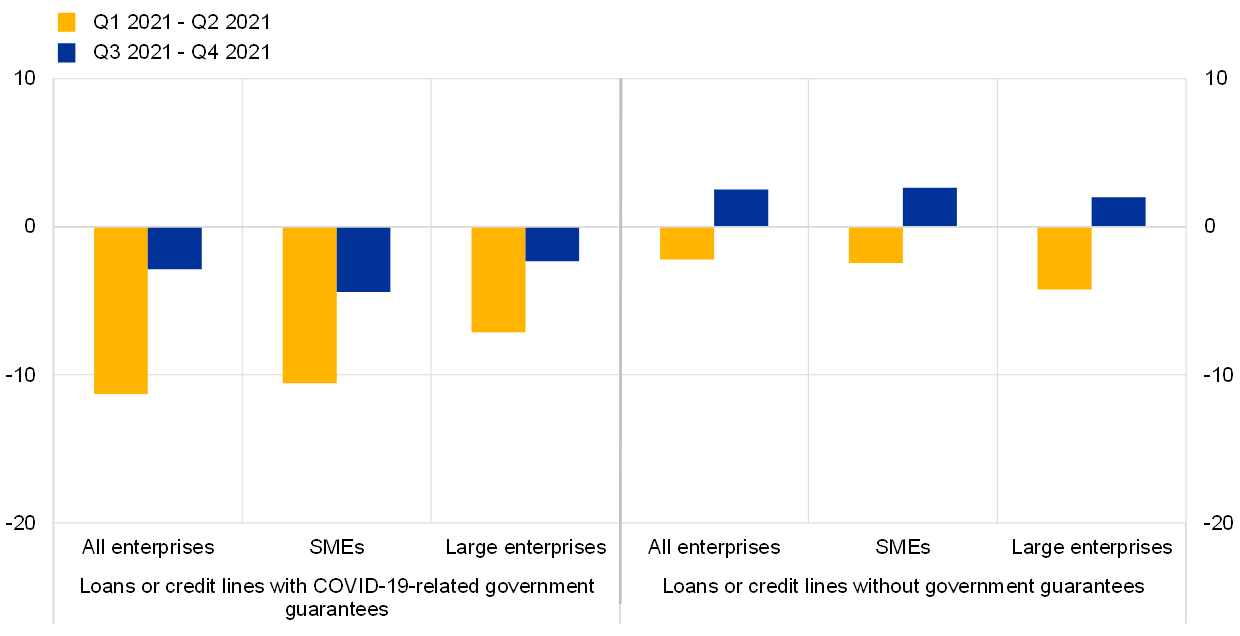
Notes: The net percentages refer to the difference between the sum of the percentages of banks responding “tightened considerably” and “tightened somewhat” and the sum of the percentages of banks responding “eased somewhat” and “eased considerably". The diamonds denote expectations indicated by banks in the current round.
In the second half of 2021, banks reported on balance a decline in demand for loans with COVID-19 related government guarantees (net percentage of banks reporting an increase in loan demand at -16%, after -24% in the first half of 2021; see Chart 22). The net decrease in demand was less pronounced for SMEs (-11%) than for large firms (-22%). At the same time, banks reported a strong net increase in the demand for loans without government guarantees in the second half of 2021 (net percentage of 11%, after -1%; see Chart 22).[11] This is in line with the overall net increase in loan demand from firms in the third and fourth quarters of 2021 (see Section 2.1).
Chart 22
Changes in demand for loans to enterprises with and without COVID-19 related government guarantees
(net percentages of banks)
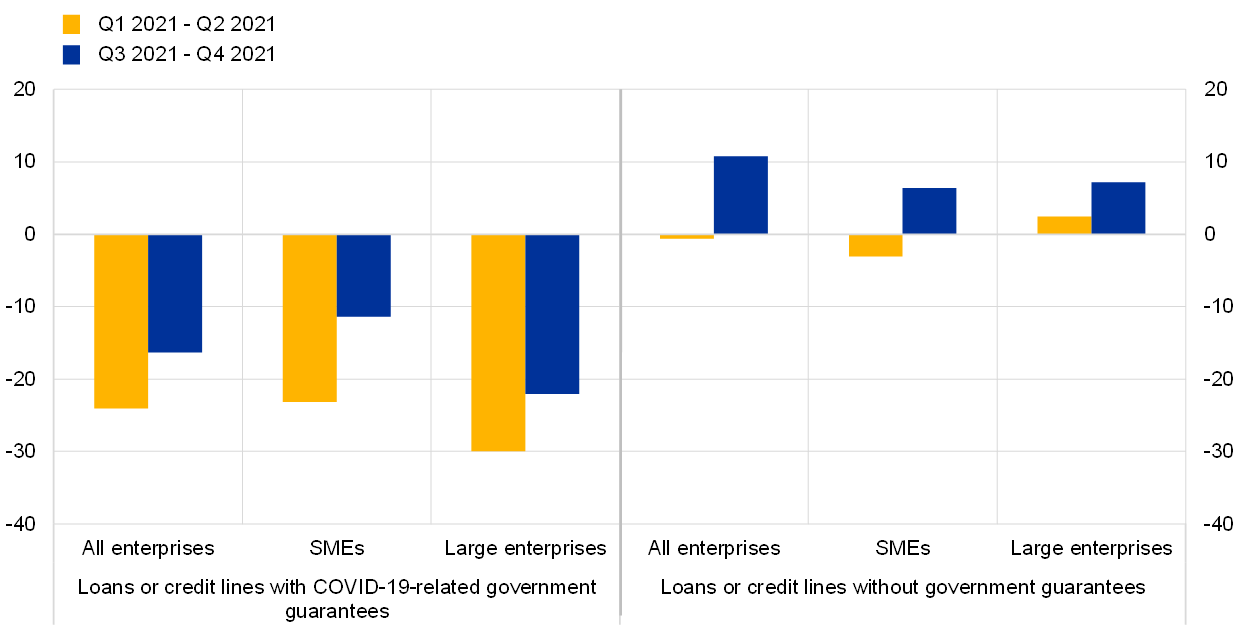
Notes: The net percentages refer to the difference between the sum of the percentages of banks responding “increased considerably” and “increased somewhat” and the sum of the percentages of banks responding “decreased somewhat” and “decreased considerably". The diamonds denote expectations indicated by banks in the current round.
In the second half of 2021, all factors contributed to the net decline in demand for loans with COVID-19 related guarantees (see Chart 23). Given the small share of loans with COVID-19 related guarantees in new lending, these results are consistent with the developments in the main factors explaining overall loan demand (see Section 2.1).
Chart 23
Factors affecting demand for loans or credit lines with COVID-19 related government guarantees
(net percentages of banks)
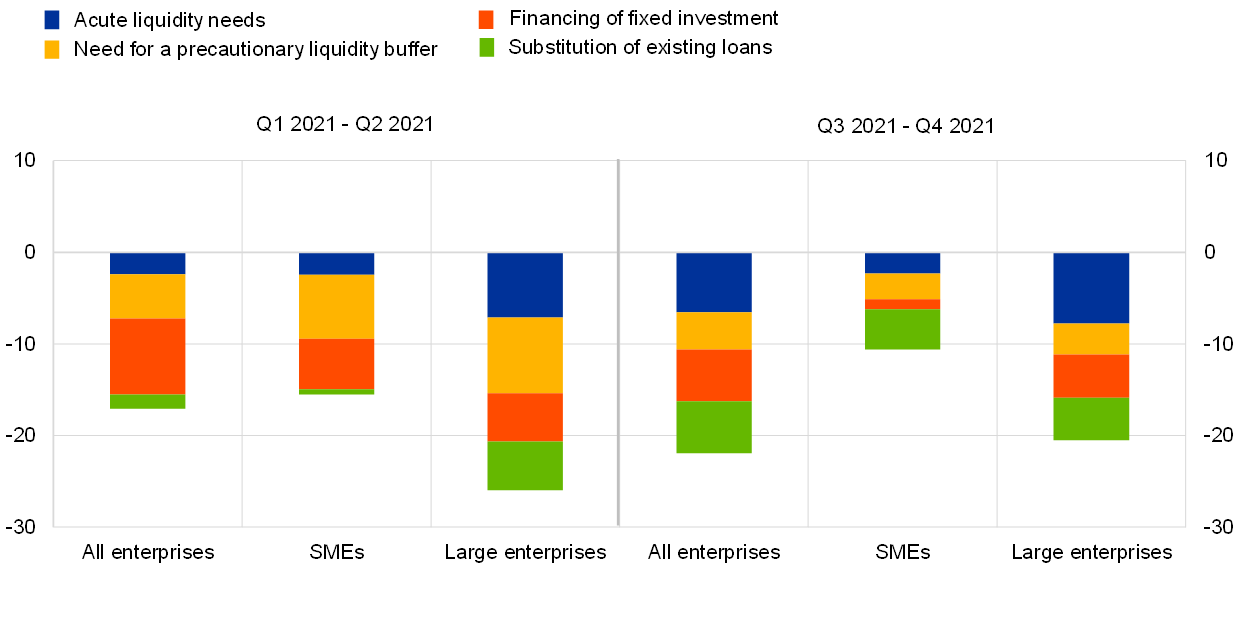
Notes: The net percentages refer to the difference between the sum of the percentages of banks responding “increased considerably” and “increased somewhat” and the sum of the percentages of banks responding “decreased somewhat” and “decreased considerably". Banks can select more than one factor that affects loan demand. Therefore, the sum of the net percentages can exceed 100 in this chart. The last period denotes expectations indicated by banks in the current round.
Annexes
See more.
© European Central Bank, 2022
Postal address 60640 Frankfurt am Main, Germany
Telephone +49 69 1344 0
Website www.ecb.europa.eu
All rights reserved. Reproduction for educational and non-commercial purposes is permitted provided that the source is acknowledged.
For specific terminology please refer to the ECB glossary (available in English only).
PDF ISSN 1830-5989, QB-BA-22-001-EN-N
HTML ISSN 1830-5989, QB-BA-22-001-EN-Q
- The four largest euro area countries in terms of GDP are Germany, France, Italy and Spain. From the January 2022 BLS onwards, the aggregation of banks’ replies to the euro area results is based on unweighted national results for all countries. This has led to small revisions for the euro area (including historical revisions). In addition, the change of the reported results for France to unweighted national results has led to some revisions.
- For more detailed information on the bank lending survey, see the article entitled “A bank lending survey for the euro area”, Monthly Bulletin, ECB, April 2003; Köhler-Ulbrich, P., Hempell, H. and Scopel, S., “The euro area bank lending survey”, Occasional Paper Series, No 179, ECB, 2016; and Burlon, L., Dimou, M., Drahonsky, A. and Köhler-Ulbrich, P., “What does the bank lending survey tell us about credit conditions for euro area firms?”, Economic Bulletin, Issue 8, ECB, December 2019.
- To ensure a good representation of national bank lending markets, the selected sample banks are generally of similar size or have lending behaviour that is typical of a larger group of banks.
- The non-harmonised historical data differ from the harmonised data mainly as a result of heterogeneous treatment of “NA” (Not Applicable) replies and specialised banks across questions and countries. Non-harmonised historical BLS data are published for discontinued BLS questions and ad hoc questions.
- The net increase in demand for loans to firms has been revised upwards from 2% to 8% in the third quarter of 2021, owing to the changes in the aggregation of euro area results introduced with the January 2022 BLS.
- Credit standards for housing loans have been revised from 8% to 2% for the third quarter of 2021 owing to changes in the aggregation of euro area results introduced with the January 2022 BLS.
- Overall terms and conditions for housing loans have been revised from 5% to 0% for the third quarter of 2021 owing to changes in the aggregation of euro area results introduced with the January 2022 BLS.
- Credit standards for consumer credit have been revised from -1% to -3% for the third quarter of 2021 owing to changes in the aggregation of euro area results introduced with the January 2022 BLS.
- Demand for consumer credit has been revised from 7% to 5% for the third quarter of 2021 owing to the changes in the aggregation of euro area results introduced with the January 2022 BLS.
- Until the January 2020 BLS, this question referred to the changes over the past/next six months. As of the January 2021 BLS, it refers to the changes over the past/next 12 months.
- Net demand for loans without government guarantees has been revised from -6% to -1% for the first half of 2021 owing to the changes in the aggregation of euro area results introduced with the January 2022 BLS.
- 1 February 2022


